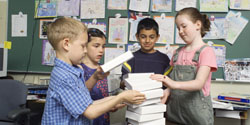
Prior Knowledge | Co-operative Learning | Feedback | Recognition | Questioning | Modelling | Managing ICT

Co-operative Learning
Teaching and Learning Strategies
Effective Cooperative Learning
| Cooperative grouping takes organization and practice. Read more > |
Examples and Resources
| Reciprocal Teaching Jigsaw Think-Pair-Share Brainstorm |
Learn About Co-operative Learning
Two heads learn better than one. This variation on the classic saying is very true for learners in a classroom. Co-operative group work is an important part of an effective classroom. However, there is much more to group learning than just having learners “work together.” The primary goal of group work is to get learners actively involved in their learning where there is an accepted common goal. This grouping allows learners to work together to maximize their own and each other’s learning.
“In a co-operative learning situation, interaction is characterized by positive goal interdependence with individual accountability.” (Johnson & Johnson, 1998)
One frustration many teachers, learners, and parents have with cooperative groups is that many times the high-achieving learners do most of the work. In order for co-operative grouping to be effective and make good use of classroom time, group work must have clear role responsibilities, goals, and individual accountability.
In a classroom setting, co-operative groups give learners opportunities to learn from and teach one another under “real” world conditions. “By the 1990’s, teamwork became the most frequently valued managerial competence in studies of organizations around the world” (Goleman, 1998). We can prepare our learners to enter the working world by giving them these valued opportunities to work together to create products and solve problems.
By organizing a classroom around co-operative group work, the ultimate goal is to get learners actively involved in their learning. Grouping learners in pairs or small groups, increases their chances of involvement. Learners feel less pressure when asked to complete a task with a peer than they do completing it independently. Co-operative learning should be used strategically. "Research has established that the co-operative structure outperforms competitive and individualistic structures academically and socially, regardless of content or grade level” (Kagan 1997). Learners often view school as a competitive enterprise where they try to outdo their classmates. Research shows that learners are more positive about school, subject / learning area, and teachers when they are provided structure to work co-operatively (Johnson & Johnson).
Make it Happen in Your Classroom
With time and patience, any teacher at any grade level can incorporate co-operative learning into teaching and learning. The keys to success are maintaining high expectations, keeping learners individually and collectively accountable, and creating a classroom environment where co-operation is encouraged.
Co-operative Grouping Across the Curriculum
Many types of co-operative grouping strategies are supported by research and can be used across grades and subject / learning areas.
Reciprocal Teaching >
A co-operative grouping strategy that calls on learners to become “the teacher” and work as a group to bring meaning to text.
Jigsaw >
A co-operative learning technique that allows greater amounts of content to be studied and shared by learners in a group.
Think-Pair-Share >
A co-operative discussion strategy made up of three stages of learner action where learners talk about the content and discuss ideas before sharing with a whole group.
Brainstorm Groups >
A co-operative learning strategy that calls upon groups of learners to brainstorm thoughts and build upon each other's flow of ideas.
References
Goleman, D. (1998). What makes a leader? Harvard Business Review. November-December, pp. 93-102.
Johnson, D. & Johnson, R. (1998). Cooperative learning and social interdependence theory: Cooperative learning. www.co-operation.org/pages/SIT.html*
Kagan, L., Kagan, M., Kagan., S. (1997). Cooperative learning structures for teambuilding. San Clemente, CA: Kagan Cooperative Learning.
